From Gazi Bay in Kenya and Maputo Bay in Mozambique to Dale Bay in Wales, projects to restore algae are gaining momentum.
Emerged over 70 million years ago from terrestrial grasses, seaweed is one of the most diverse and valuable marine ecosystems on the planet. They have a critical role in combating climate change, food security, shoreline protection, biodiversity enrichment, disease control and water filtration.
Underwater algae meadows – expanses of green, grass-like shoots and flowers – are an extremely effective “natural solution” to climate change. They cover only 0.1 percent of the world’s ocean floor, while storing about 18 percent of the ocean’s carbon. They are also home to fish stocks, which not only provide food and livelihoods for coastal residents, but also help increase ocean biodiversity.
According to a study by the United Nations Environment Program (UNEP), algae habitats are in serious danger. They have been in decline since 1930, and today 7 percent of seaweed habitat is lost each year, the equivalent of an area the size of a soccer field disappearing every 30 minutes.
Climate change, as well as increasing coastal populations, deepening of the seabed and ocean floor, and uncontrolled fishing have all contributed to this decline.
Algae-covered areas are among a growing number of ecosystems, including forests, savannahs and mountains, under pressure from human activities. Every year the world loses so many trees that they could fill the Republic of Korea, and since 1970, 30 percent of natural freshwater ecosystems have disappeared.
As the world prepares to enter the UN Decade of Ecosystem Restoration, a global movement to revive natural areas and reverse the destruction of algae will require international efforts, experts say. Algae are found in coastal regions of 159 countries on six continents and cover about 300,000 km2.
The increase and expansion of coastal populations, pollution, dredging and fishing make us aware of the impact of these activities on the planet’s ecosystems.
The project is funded in part by the sale of “carbon credits” and demonstrates how collaboration between local, national and international organizations can lead to successful ecosystem restoration.
The income from the project supports the further development of the ecosystem and the local community. The Mikoko Pamoja project helped dig wells and provide drinking water for 3,500 people, and provided 700 children with educational materials. In addition, local schools were repaired and improved. The project was so successful that it was awarded the Equator Initiative for addressing climate change at the community level. This activity evolved into the development of the larger Vanga Blue Forest project, mainly focused on the restoration and protection of mangrove forests. The project received seed funding from the Leonardo Dicaprio Foundation.


